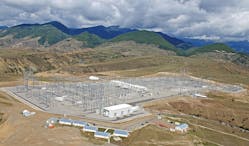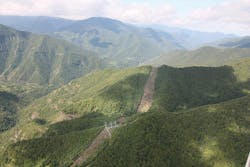The Black Sea transmission network project is the largest electric power project implemented in the Republic of Georgia since the early 1990s, when Georgia regained independence. The project actually dates back to the 1980s, when construction of a 258-km (160-mile) 500-kV overhead transmission line commenced to interconnect two existing substations, Zestaponi and Gardabani, with the line routed through southern Georgia to create a 500-kV loop. At the time, the aim was to improve electrical interconnections in the South Caucasus republics of Georgia, Armenia and Azerbaijan as well as to strengthen Georgia’s transmission system. However, following the 1991 collapse of the Soviet Union, construction work on the transmission line stopped with only one-fifth of the circuit complete.
Despite the efforts of the Georgian government in the late 1990s and beginning of the 21st century, including the initiation of bilateral and multilateral arrangements with the neighboring states, no tangible progress was achieved. Meanwhile, because of the political and economic hardships that hit Georgia severely in the 1990s, the completed sections of the overhead line lacked proper attention and, as a result, were vandalized. Then in 2004, the U.S. Agency for International Development (USAID), U.S. Energy Association and transmission system operators of the states in the Black Sea region initiated a project to develop a common regional transmission planning model.
Subsequently, the Georgia Ministry of Energy commissioned several studies, funded by USAID, to identify the least-cost technical options for improving reliability of its national transmission system, exporting renewable energy to Turkey and attracting investments in the development of new hydropower projects. Georgia has an abundance of renewable energy sources such as hydropower and wind, while the bordering country of Turkey has a rapidly growing demand for energy. With a transmission system designed for an independent state, Georgia had to overcome the challenge of breaking down existing border barriers and connecting transmission systems with different technical parameters to establish a means of exporting surplus renewable energy.
Project Funding
Based on the Georgia Ministry of Energy’s studies, the country decided to complete the partially constructed 500-kV overhead transmission line, construct the 500/400/220-kV Akhaltsikhe substation and establish a cross-border 151-km (94-mile) 400-kV alternating-current (AC) overhead transmission line to Turkey. As Turkey was planning to join the synchronous grid of continental Europe, the European System of Transmission System Operators for Electricity (ENSTO-E) precluded Turkey from any synchronous connection with non-ENTSO-E transmission systems. As a result, the installation of a high-voltage direct-current (HVDC) interconnector proved to be the best technically and commercially viable alternative.
The Black Sea transmission network (BSTN) project was financed by several European financial institutions. The European Bank for Reconstruction and Development and the European Investment Bank each provided loans of 80 million euros, and the German Reconstruction Bank provided an additional 100 million euros. The contribution from the Government of Georgia amounted to 53 million euros, and the Neighborhood Investment Facility of the European Union granted an additional 8 million euros.
The BSTN project tenders were subject to international competitive-bidding procedures in three lots: two contracts for the Akhaltsikhe substation — one for HVDC equipment and the other for 500/400/220-kV equipment—were awarded to Siemens, and the contract for construction of the 500-kV and 400-kV overhead transmission lines in Georgia was awarded to KEC International. In addition, the Turkish transmission system operator, Türkiye Elektrik İletim A.Ş. (TEIAS), undertook construction of the Turkish section of the interconnecting 400-kV overhead line, which included 120 km (75 miles) as well as the expansion and upgrade of the Borchka substation.
Georgia System
The BSTN project was developed by Georgian State Electrosystem, the state-owned transmission system operator, and its daughter utility, Energotrans Ltd., which was responsible for construction and operation of the Akhaltsikhe substation as well as the new 500-kV and 400-kV overhead transmission lines. The 500-kV overhead transmission line originally was planned to provide a direct circuit between the Zestaponi and Gardabani substations, but now these two existing substations are interconnected by independent 500-kV overhead transmission lines to the recently commissioned 500/400/220-kV Akhaltsikhe substation in southern Georgia, located 30 km (19 miles) from the Georgia-Turkey border.
These 500-kV overhead transmission lines are strung with triple-bundled aluminum conductor steel-reinforced (ACSR) 300/67 conductors per phase, composite (polymer) insulators and an optical ground wire (OPGW). Differential and distance protections have been installed in the new 500-kV line bays constructed in the Zestaponi and Gardabani substations for the circuits connected to Akhaltsikhe substation.
Some of the overhead transmission line sections are routed through protected areas in dense forests and the alpine zone, which has an elevation of 2000 m (6560 ft) above sea level. Because of the complex terrain, and to minimize the environmental footprint particularly in the forest area, the line was designed with increased span lengths. While most spans are between 800 m to 1000 m (2625 ft to 3281 ft), the longest span is 1651 m (5417 ft). In the alpine section where turbulent winds occur during winter, special measures were used for fixing the jumpers.
The BSTN project was constructed using the high environmental standards in accordance with environmental guidelines established by the financial institutions. Special slope protection measures were taken along the substation and tower access roads, including the installation of gabions. In addition, towers erected along the sections crossed by birds during seasonal migration were equipped with perch discouragers.
Akhaltiskhe Substation
The 500/400/220-kV Alhaltiskhe substation, constructed by Siemens, is located 13 km (8 miles) from the city of Akhaltsikhe on a site approximately 1100 m (3609 ft) above sea level. The substation is connected to the Tbilisi-Akhaltsikhe highway by a 3.2-km (2-mile) access road constructed as a part of the project.
The 500-kV and 400-kV switchyards of the Akhaltsikhe substation are designed with the breaker-and-half-bus configuration. The substation’s 500-kV switchyard is connected to the 220-kV side by three 167-MVA single-phase autotransformers, which were installed to interconnect the substation with hydropower plants currently under construction in the region. The Akhaltsikhe substation may be operated either from the local control room — using Ethernet or a local area network — or remotely from the national dispatch center through the power line carrier system using multiplexers.
In each HVDC link, the three-phase AC of the 500-kV feeding network is linked with converter valves by three 140.4-MVA, 500/40/40-kV single-phase converter transformers, then converted into direct current (DC) and transmitted directly through the DC link to the inverter station. There, the DC is converted back into three-phase current with a simultaneous adjustment to the parameters of the network, before being connected to the three 140.4-MVA, 400/40/40-kV single-phase converter transformers. The HVDC links are designed to transmit 350 MW in both directions.
Three synchronous condensers, with capacities of 60 MVAR each, are installed for compensation of the reactive power and capable of operating under the N-1 contingency. Each synchronous condenser is connected to the 400-kV side of the substation through the individual 63-MVA, 400/11-kV transformers. During the operation of the HVDC links, these synchronous condensers maintain the reactive power at near-zero level. Each control, protection and measurement system is designed with redundancy. The changeover logic of the system selection function ensures, at any given time, only one system actively controls the process.
During construction of the Akhasltiskhe substation, certain logistical challenges were experienced, particularly related to the transportation of heavy equipment. For example, the 14 converter transformers each weighed 120 tons without oil.
Interconnecting Line
The cross-border 151-km (94-mile) 400-kV interconnecting line links the 500/400/220-kV Akhaliskhe substation in southern Georgia to the 400-kV Borchka substation in Turkey. The contract for construction of the 30-km section in Georgia was undertaken by KEC, and the contract for construction of the 120-km (75-mile) section between the Georgia-Turkey border and the Borchka substation was the responsibility of TEIAS. Like the 500-kV line constructed in Georgia, the 400-kV transmission line construction also included triple-bundled ACSR 300/67 conductors per phase, composite (polymer) insulators and OPGW.
The cross-border transmission line and HVDC links provide a seamless interconnection of the Georgian and Turkish high-voltage transmission systems, and they effectively bring the electric power systems of Georgia and its regional neighbors closer to Turkish and European electricity markets.
Staff Training
The specialized back-to-back HVDC equipment installed in the 500/400/220-kV Akhaltsikhe substation required operator training for Energotrans personnel. Georgian State Electrosystem conducts ongoing training focused on operation and maintenance practices. In addition to technical features of the BSTN project, well-tailored and extensive training is required on the new contractual arrangements related to scheduling and capacity allocation procedures uncommon in the local electric power sector operations. However, these are controllable challenges that, with appropriate preparation, are mandatory prerequisites for competent involvement in international energy markets.
A Bright Future
Georgia became the first country in the South Caucasus to use HVDC technology, after successful commissioning of two HVDC back-to-back links in December 2013. The completion of the BSTN project is of great importance for ensuring sound operation of the entire Georgian transmission system. The project contributes significantly to improved stability of the transmission system, a more reliable power supply to southern Georgia, a reduction in electricity loss as well as providing effective opportunities for exporting excess electricity, generated during the summer period, to Turkey.
Georgia has vast unexploited and viable hydropower and wind resources. Currently, the country has exploited only 20% of its potential hydropower resources, so the potential for expansion is huge. The country’s largest hydropower project completed was the 640-MW Khudoni hydropower pipeline. Two additional hydropower projects were completed recently: the 108-MW Dariali project was completed in 2016 and the 50-MW Paravani project was completed in 2017. Both are operating successfully. Furthermore, 15 to 20 hydropower projects are in different stages of construction. Exploitation of the country’s wind resources is still the subject of feasibility studies.
The commercial viability of all these projects is directly linked with export opportunities to Turkey, where the BSTN project is of the highest importance. With completion of the BSTN project, a substantial increase in investments in Georgian hydropower is expected. In turn, more investments in the generation facilities will lead to the need for additional exporting capacities and further development of the national high-voltage transmission network.♦
Kakha Sekhniashvili graduated with an honors degree in macroeconomics from Tbilisi State University in Georgia in 1996 and joined the National Bank of Georgia. Following a steady career progression at the Bank of Georgia, Sekhniashvili was appointed deputy minister of the Georgia Ministry of Economic Development in 2005. He served as head of the State Treasury of Georgia from 2007-2010 and then was appointed director of Energotrans Ltd.




